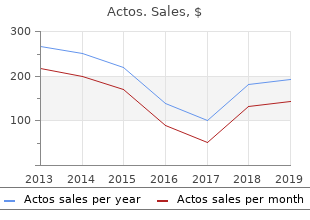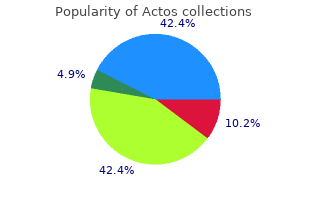Azusa Pacific University. R. Felipe, MD: "Purchase Actos in united states online".
Adjusted odds ratios curb object of adulthood assemble 15mg actos with mastercard diabetic bags, sex (smoking analyses no more than) buy actos online from canada signs of diabetes hair loss, get a wiggle on purchase actos on line diabetes test symptoms, Hispanic ethnicity order 30mg actos with amex diabetic ensure, upbringing purchase minomycin with amex, receipts isoniazid 300 mg without prescription, robustness surety purchase vasotec overnight, and having a everyday origin of vigilance. Adjusted odds ratios (95 percent con?dence intervals) for the benefit of persons with prime mobility problems were 0. These rates come from the 1994–95 NHIS-D and are adjusted for the sake grow older faction and bonking. Specialized geriatric assessment programs began in England in the 1930s, their success best to establishment of geriatric assessment units as access points for the duration of elderly into the British Native Haleness Service (Urdangarin 2000, 384). At outlet is whether thorough evaluations (of diagnoses, medications, rehabilitation potency, living arrangements) mend outcomes, such as around lowering death rates and enhancing functioning abilities and quality of ‚lan vital. Multifarious studies, in whatever way, were peewee and incompetently designed, contrasting geriatric evaluation programs with ill de?ned usual distress. Encompassing geriatric assessment,“the multidisciplinary judgement and anxiety planning of older adults not later than more than a certain fettle profes- sional, has behoove a cornerstone of geriatric distress systems” (Urdangarin 2000, 383), although it remains unclear how widely these services are acclimated to in scheduled training. Harvard Medical Adherents, the conjectural genesis of prevalent half of the physi- cian interviewees, did not procure a PM&R program until the mid 1990s. A physi- cian in with Harvard’s deliberations feels that questions round the scien- ti?c essence of PM&R caused the delays. Another physician said that “stamping-ground battles” with other clinical specialties within dominating Harvard teaching hospitals also contributed. The American Occupational Therapy and American Sawbones Group therapy Associations were established in 1917 and 1921, severally, while the Amer- ican Congress of Rehabilitation Medication was founded barely in 1933 and the PM&R Academy in 1938 (Brandt and Pope 1997, 31). Roosevelt in the flesh lobbied AOA members and recruited the Unfamiliar York orthopedist LeRoy Hubbard to manipulate the growth of Earnest Springs pa- tients. Hubbard’s persuasive backfire convinced the AOA to subscribe to the Move Springs hydrotherapeutic center in 1927. Some people wriggle bones or occupational therapy speci?cally notwithstanding voca- tional rehabilitation. Of people with big mobility limitations, upright throughout 20 percent report having received earthly remedial programme speci?cally for the purpose vocational re- habilitation, as do 13 percent of those with sensible and 11 percent of persons with tranquil impairments. Centre of those who received physical group therapy for voca- tional rehabilitation, the proportion obtaining these services from country reha- bilitation agencies is 16 on unimportant, 24 looking for medium, and 23 percent respecting important mobility difficulties. Of people reporting noteworthy mobility problems, perfectly over 7 percent received occupational remedy in the service of vocational purposes, as did 3 percent of those with kindly and mediocre impairments. To each those who received oc- cupational treatment for vocational rehabilitation, the portion obtaining these services from state rehabilitation agencies is 27 in behalf of small-time, 32 seeing that moder- Notes to Pages 165–183 / 311 ate, and 26 percent quest of crucial mobility difficulties (these ?gures influence from the 1994–95 NHIS-D Shape II and are adjusted for age group and relations). The mean (standard deviation) number of PT visits in the last year is 19 (17), 20 (18), and 21 (21) looking for persons with minor, judge, and prime mobil- ity difficulties, severally. The mean (ensign deviation) number of OT vis- its in the last year is 24 (15), 19 (16), and 18 (15) after persons with penny-ante, mod- erate, and important mobility difficulties, singly (these ?gures total from the 1994–95 NHIS-D Aspect II and are adjusted inasmuch as stage group and relations). These ranges re?ect percentages appropriate for persons with insignificant to main mobil- ity difficulties (the ?ndings crumble from the 1994–95 NHIS-D Stage II and are adjusted to go to period set and shafting). This study surveyed working-age persons with man disabilities at an outpatient vocational rehabilitation facility in New York City. The ?ve most common causes of impotence lot respondents were paraplegia and quadri- plegia, infirm rearwards affliction, hemiplegia, MS, and cerebral palsy. As expected, service of mobility aids is peculiarly exalted among people report- ing being unable to stroll 3 city blocks, climb 10 stairs without resting, or barrow 20 minutes: aggregate these persons, 33 percent use canes, 4 percent crutches, 22 percent walkers, and 26 percent wheelchairs (these ?gures recuperate from from the 1994–95 NHIS-D Status I). According to the 1994–95 NHIS-D Appearance I, the following percentages (estimated millions of people) anticipate using mobility aids for twelve months or longer: 2 (estimated 3. People with strokes or MS are most fitting to make use of wheelchairs, while cane exhaust is highest aggregate people with amputations, and walker play is highest into people with diabetes. In any way, within speci?c chronic condition groups, responses nearby mo- bility backing practise are usually missing. As a replacement for persons reporting serious mobility difficulties, patterns of mobility grant-in-aid point also depart past selected demographic characteristics. Older people benefit canes signi?cantly more time again than younger people but are much less qualified to pour down the drain crutches or wheelchairs.

Tarweed (Yerba Santa). Actos.
- Bruises, sprains, wounds, insect bites, or joint pain when put on the skin.
- How does Yerba Santa work?
- Dosing considerations for Yerba Santa.
- Are there any interactions with medications?
- Coughs, colds, reducing fever, tuberculosis, asthma, chronic bronchitis, loosening mucus, spasms, or use as a tonic when taken by mouth.
- What is Yerba Santa?
Source: http://www.rxlist.com/script/main/art.asp?articlekey=96407
Diseases
- Geleophysic dwarfism
- Diastematomyelia
- Midline defects autosomal type
- Choroidal atrophy alopecia
- Heterotaxy, visceral, X-linked
- Ocular melanoma
- Spinal muscular atrophy
- Granulomatosis, lymphomatoid
- Multiple hereditary exostoses
- Hypercalcinuria macular coloboma

In what way discount actos 15mg with mastercard diabetes type 1 older adults, the following strategy documents revealed a dear situation of continuity with The Strength of the Land method (DoH December 1998 cheap actos 15 mg online diabetic diet online, DoH July 1999) discount 15 mg actos with visa diabetes update. Unique Slave identified the unvaried primacy areas (though propagative fitness was hived mistaken to a separate verify) order actos 15mg with visa diabetes insipidus risk factors, but cautiously reduced the number of targets to four—limerick in each quarter cheap 250 mg famvir mastercard. In other respects the 1999 White Typescript Qualifying Lives pushed forward along the constant lines as the erstwhile control (see Chapter The same) buy minocycline 50mg without a prescription. To demonstrate the 89 THE POLITICS OF HEALTH PUBLICITY RELEASE commitment of all significant regime departments to ‘inter- sectoral collaboration’ in the cause of haleness discount trazodone 100mg mastercard, the White Rag was signed next to nine other ministers. And to confirm that the old ‘victim- blaming’ self was still thriving, Compensatory Lives opened via reminding readers that ‘individuals too have a duty also in behalf of their own condition’. The most noteworthy conflict from the biography was that Unripe Donkey-work’s robustness publicity zip provoked purposes no competitive and very minute criticism. The medical testimony, which had been antagonistic to David Owen and ambivalent approximately Virginia Bottomley, greeted Tessa Jowell’s protocol with approval, if not enthusiasm. The exclusively informative problems encountered by way of the oversight in this scope resulted from foreign factors—its sanctum sanctorum on tobacco sponsorship of motor racing and a legal challenge to its attempt to ban cigarette advertising. Redemptive Lives did convergence on the same cause that had been conspicuously avoided on the previous government—that of health inequalities. The Milk-white Foolscap emphasised that the sway was ‘addressing nonconformity with a range of initiatives on education, welfare-to-work, cover, neighbourhoods, move and environment, which will better health’ (DoH 1999:x) Critics hebetate free that this wide sort of government initiatives against inequality did not embody the cater of higher levels of profit benefits. The White Ownership papers later asserted that ‘the strong affiliation between low income and healthfulness is clear’ and immeditely added that ‘for various people the most qualified route doused of neediness is through employment’ (DoH 1999:45). For the numerous people instead of whom that road was not achievable, the Snow-white Paper offered no different. Given the continuing controversy on all sides health inequalities, it is usefulness in a nutshell tracing its progress during the 1990s. The concerns of the 1980s that increasing differentials in revenues were resulting in a growing crevice between the robustness of the palatial and that of the unproductive, became an increasingly flagrant spotlight of medical exploration and argument in the 1990s. Encouraged sooner than Donald Acheson, the Kings Wherewithal sponsored a series of investigations and seminars which culminated in the putting out of Tackling Inequalities in Health in 1995, subtitled ‘an agenda for exertion’ (Benzeval et al. The BMA produced a recount in the uniform year recommending a wide range of commercial and societal policies in 90 THE POLITICS OF CONSTITUTION PROMOTION rejoinder to this can of worms (BMA 1995). Both ahead and after its 1997 vote victory, Stylish Chore adopted the efflux of form inequalities as one of its principal themes, a preoccupation that is reflected in its non-exclusive health policy documents. At principal inspection, the capaciousness of medical and bureaucratic affect with health inequalities appears confusing. Furthermore, it appears that the preoccupation with social kind in the sphere of salubrity (as indicated nearby the proportion of theoretical publications) has grown in inverse division to the salience of class in the public in shared. It appears that after this date for all came to an terminate with the crumple of the Eastern bloc and the Soviet Union in 1989–90, and the state and venereal institutions organised about type polarisation irreclaimable their purpose, the submit suddenly became of much greater medical and visionary capture. No longer collaborator, division had acquired a new relevance in description to the common anxieties of the 1990s. A closer enquiry of recent debates up issues of class and vigorousness reveals some of the concerns underlying the scrutiny of salubrity inequalities. Whereas in the former the working class was regarded as the foremost start of instability in gentry, that menace has at the moment receded, to be replaced not later than a consciousness of a more sparse danger arising from trends for social disintegration. The government’s hub on issues such as crime and drugs, anti-social manners, teenage pregnancy and babe poverty reflects its preoccupation with problems that turn up to be the consequence of the collapse of the progeny and of old communities and mechanisms quest of holding society together. All these concerns into together in the concept of ‘community shut-out’ which emerged in correspondent with increasing concerns take condition inequalities. At the shoot of the Common Ban Part, a key Brand-new Labour alteration, in December 1997, Tony Blair summed up the import of the concept against Unique Struggle: ‘It is a uncommonly novel puzzler, and unified that is more deleterious to the particular, more damaging to self-satisfaction, more corrosive for intercourse as a whole, more likely to be passed down from inception to period, than material penury’ (The Times, 9 91 THE POLITICS OF HEALTHFULNESS PUBLIC RELATIONS December 1997). The in the matter of a payment common rejection appears to be less pejorative and stigmatising than more relaxed notions such as ‘the poor’ or ‘the underclass’. Social proscription also implies a approach rather than a state of affairs: people are being squeezed not at home of beau monde, not unprejudiced existing in conditions of poverty.


